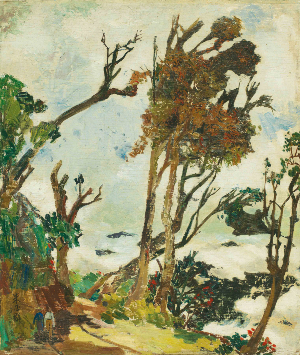EXHIBITED:
Chu Teh-chun 88 Retrospective, National Museum of History, Taipei, September 19-November 23, 2008
ILLUSTRATED:
Chu Teh-Chun, Galerie Enrico Navarra, Paris, 2000, color illustrated, pp. 18-19
CHU Teh-chun, 88 Retrospective, National Museum of History, Taipei, Thin Chang Corporation, Taipei, 2008, color illustrated, p. 75
Chu Teh-chun, Artist Publishing Co., Taipei, 2011, color illustrated, p. 33
(The above dimensions were incorrectly put as 72 x 60 cm in the illustration.)
Catalogue Note:
Looking at the changes of Chu Teh-chun’s painting style from figurative to abstract, it can be seen that the “Realistic Landscapes” he created in Taiwan in the early 1950s evolved into the “Abstract Composition Series” in the late 1950s when Chu travelled to France. Then, in the 1990s, it became “Splendid Color Ink Painting”. These three periods echo one another, comprehensively presenting the exploration and artistic achievements of a Chinese art master over half a century.
In 1949, Chu Teh-chun moved from mainland China to settle in Taiwan. Starting in 1951, he served as an instructor in the fine arts department of Taiwan Normal University while continuously creating art. Along with fellow teacher Yuan Shu-jen, Chu would bring students to the Baxian Mountain in Heping Township of Taichung County to sketch. The mountain is more than 2,000 meters above sea level and is famous for its lush forest scenery.
Created in 1954, “Sketches in Baxian” is a representative work of “Realistic Landscapes” from Chu Teh-chun while in Taiwan. The work depicts towering ancient trees and dense forests. The structure of the painting is rational and calm, showing Chu’s skill in realism and abundant experience in composition. His brushwork is lively, his colors are bright, and his lines are vivid. This work painted in oil reveals the charm of traditional Chinese painting. “Sketches in Baxian” marks Chu’s entrance into a more mature stage of his career as well as serves as a turning point in the methods of his creative style. Stylistically, it exhibits features very similar to those of post-impressionist painters like Paul Cézanne. Chu pays close attention to subtle details of color and light effects, while also exploring expressive lines with a calligraphic character. In an article, Remembering Wu Da-yu, Chu Teh-chun recounts: “As a student of Wu Da-yu, I worshipped Cézanne. During my years of work in China, I never strayed far from the methods of post-impressionists. But in 1952, I was painting scenes on Baxian Mountain. And, there on that 2000-plus meter peak, with its deep valleys, mists, and forests, I had a sudden revelation. I began to understand the way Chinese ink-wash painting presents forms and empty spaces, and the relationship of its poetic, traditional spirit with nature. Thick mists surrounded me, crisscrossed with branches of pine and cypress. This reminded me of the styles of brushwork used in calligraphy. Additionally, mixed in were the feelings I remembered having as I learned calligraphy and painting. Before I knew it, my view of painting had changed.” This shows the significance of Baxian Mountain in Chu’s artistic career. It undoubtedly provided him with an opportunity to move toward a more lyrical and abstract style by combining Chinese and Western styles.
Chu Teh-chun’s early works produced in a realistic manner are extremely difficult to find today, especially the paintings from his time at the Hangzhou Academy of the Arts. The works were completely destroyed during war and migration. Therefore, such works as those of the “Sketches in Baxian” series are very rare.
